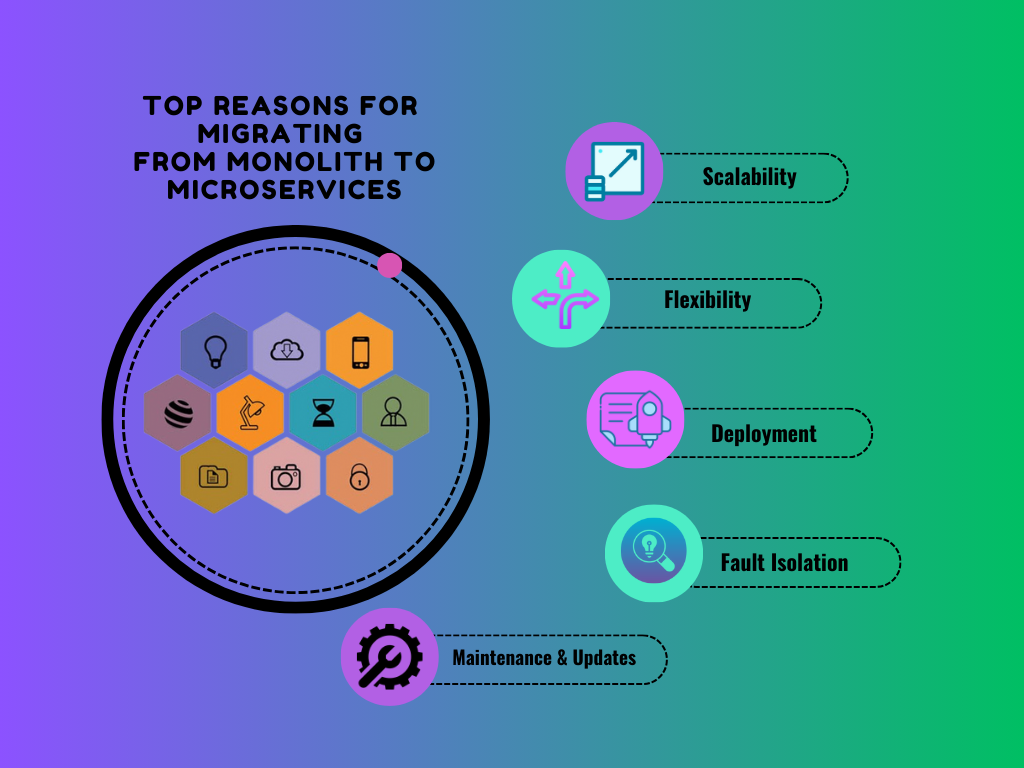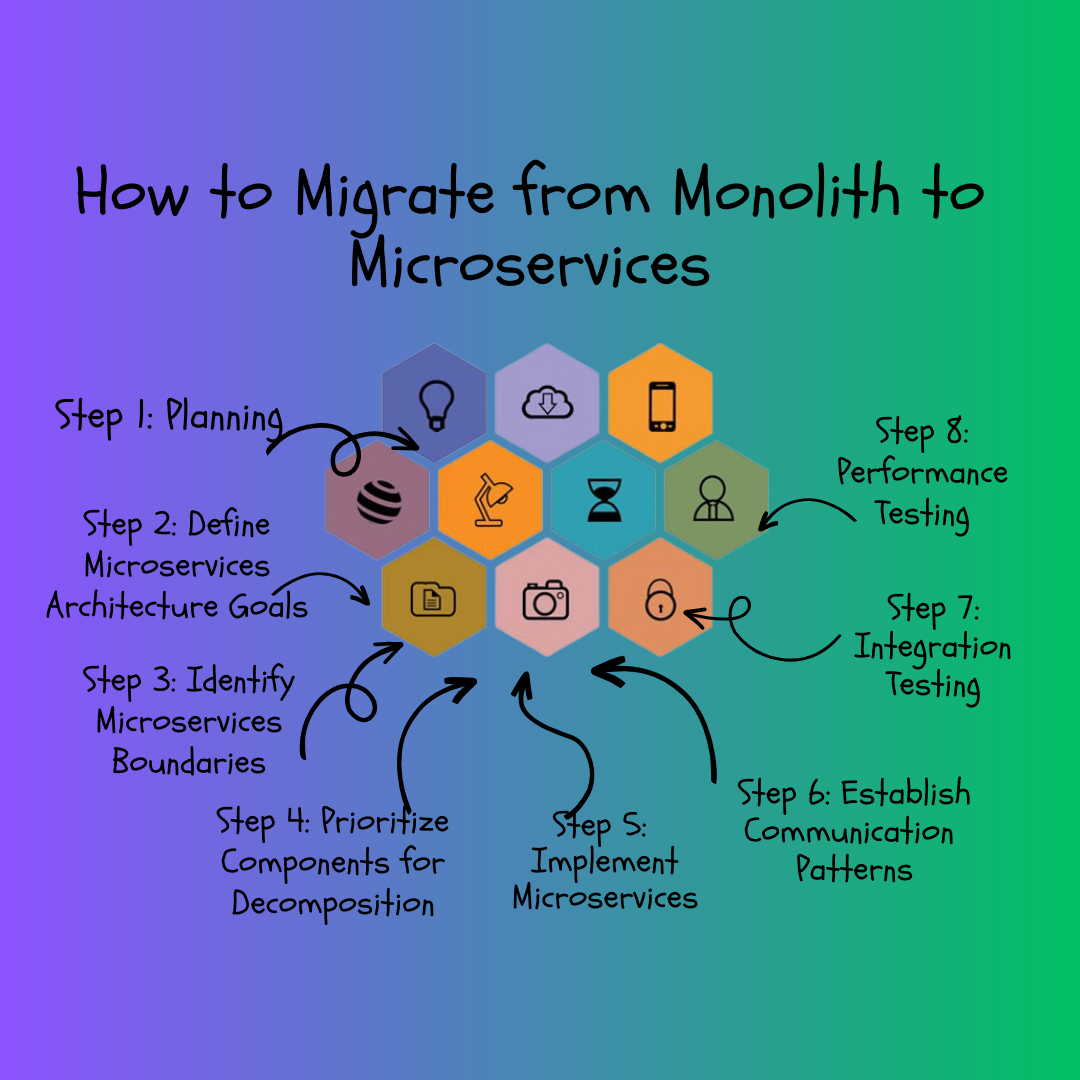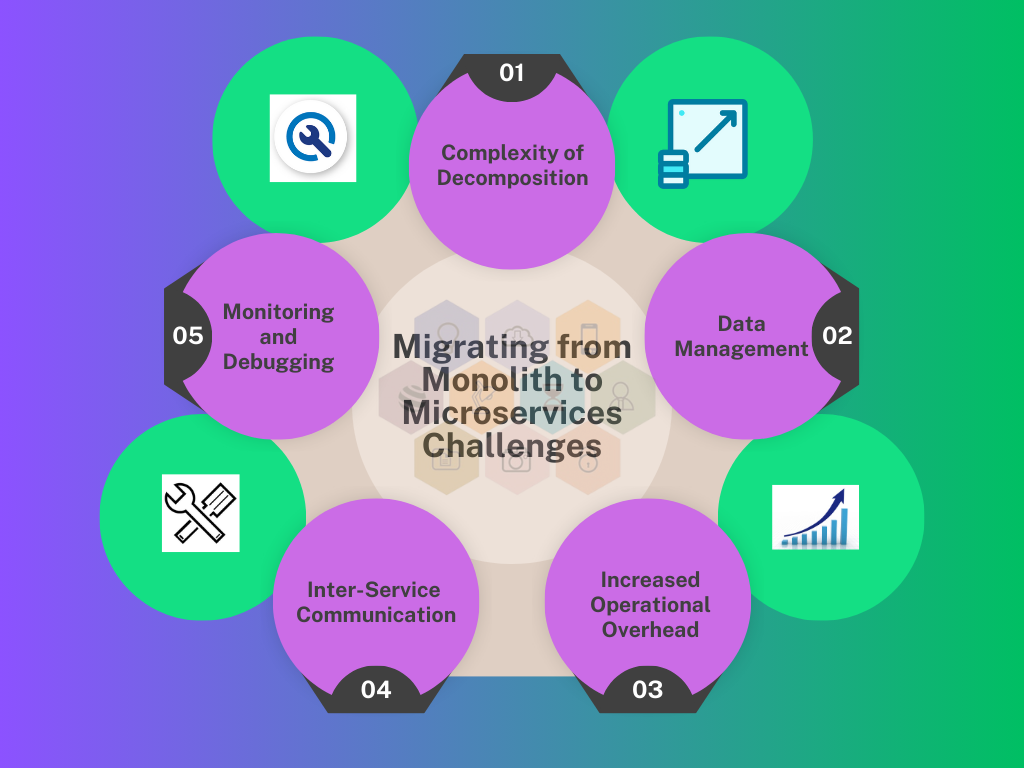Microservices are an architectural style that structures an application as a collection of small, independent services that can be developed, deployed, and scaled independently. This approach follows a service-oriented architecture (SOA), meaning that each service your team deploys is a self-contained unit with a well-defined use case. As a byproduct, a microservices architecture enhances fault isolation, enables focused teamwork, and optimizes system resiliency and reliability.
More of the top reasons for businesses to migrate from a monolithic to a microservices architecture are covered below.
Key Takeaways:
Migrating to microservices improves productivity, scalability, and flexibility.
To fully benefit from the microservices architecture and ensure a successful transfer, careful planning, and execution are essential.
There are various benefits to microservices when compared to monolithic architectures.
There are several challenges associated with migration, such as data management and gradual decomposition.
Planning, goal-setting, boundary-drawing, component prioritization, microservices implementation, communication-setting, and testing are all part of the migration process.
5 Top Reasons for Migrating from Monolith to Microservices
There are several advantages to switching from monolith to microservices. Most commonly, we see teams adopt microservices because they run into one of the following challenges:
- Their monolithic application becomes harder to scale as the codebase increases in complexity
- They’re worried about reliability, given a failure in one component of their monolith can take down the whole system
- Their monolith creates a “waterfall” style of application development, slowing developer velocity
Here is a table representation of the comparison between a monolithic and a microservices architecture:
| Aspect | Monolith | Microservices |
|---|---|---|
| Scalability | Limited scalability: Face several challenges as they grow. | High scalability: Supports distributed systems. |
| Flexibility | Low flexibility: Several software functionalities are impacted by a minor change. | High flexibility: Offers ease of application modification and flexibility. |
| Deployment | Slow deployment, as teams have to work on the application in succession. | Fast deployment, as teams can work on different parts of the application in parallel. |
| Fault Isolation | Low: A bug in one part can affect the entire system. | High: A bug in one part does not affect the whole system. |
| Maintenance and Updates | Tightly coupled codebase. | Loosely coupled and modular. |
Microservices offer significant advantages and serve as a reliable and effective solution for modern applications since they enable easy scaling, seamless updates, fast deployment, enhanced system resilience, and reduced long-term maintenance costs.

The following are the primary reasons for migrating from monolithic to microservice architecture:
1. Scalability: Migrating from monolith to microservices makes managing multiple devices and apps easier.
Microservices are ideal for businesses that need to quickly scale resources in response to user demand. Since you can scale individual components (versus the whole system), microservices make scaling easier and more efficient.
For example, you can scale up the authentication service independently to meet high demand without impacting other system components. This adaptability helps organizations promptly respond to shifting needs.
2. Flexibility: Teams can use multiple technologies and languages for different services.
Microservices offer flexibility by enabling the use of diverse languages and technologies for distinct services, hence offering flexibility and optimizing performance, creativity, and developer productivity. Each microservice can be built using the best tools and frameworks for its unique functionality.
The migration not only maximizes efficiency for particular jobs but also enables teams to make use of the advantages offered by different technologies. Developers can choose the most appropriate tools and technologies for each service without compromising the functionality or interoperability of other services.
3. Faster Development and Deployment: Reduce complexity and delays.
Microservices architecture reduces complexity and delays by empowering remote teams to work independently. Multiple teams can simultaneously build, test, and launch individual services in a microservices architecture, which speeds up time-to-market and streamlines the development process.
Development and testing can proceed faster when multiple teams can work without interference, speeding up development and testing. Additionally, updates and new features may be implemented faster, which improves flexibility and responsiveness to market needs.
4. Fault Isolation: Failure in one service does not bring down the entire system.
Isolating services within a microservices architecture significantly improves the system’s dependability and uptime. Since each service operates independently, problems in one area are isolated and do not affect the functionality of others.
A bug or an error in one part of a monolithic application might render the entire system unusable. In a microservices architecture, if one service fails, it doesn’t affect the others—they can keep working.
5. Easier Maintenance and Updates: Make debugging easier and enable quicker error detection and correction.
Debugging becomes easier to handle in a microservices architecture due to the modular nature of the services. Each service runs independently, making it easier to isolate and identify problems. This streamlined debugging procedure enhances the microservices architecture’s overall stability and reliability.
Microservices make maintenance and upgrades easier by letting modifications be made to one service independently of others, which lowers the possibility of problems affecting the entire system. Developers may update, debug, and deploy individual microservices without impacting the system as a whole because each microservice is an independent entity.
Continue reading to learn crucial steps to follow to ensure a smooth transition when migrating to microservices from a monolithic architecture.

Steps on How to Migrate from Monolith to Microservices
Architecture, careful planning, and execution are essential for a smooth migration from a monolithic to a microservice. Every stage of the migration process, from evaluating the current monolith to creating and deploying microservices, is vital to the overall success of the project, which will increase the organization’s scalability, agility, and efficiency.
For a seamless transition from monolith to microservice architecture, follow this step-by-step approach.
Step 1: Planning
Conducting a thorough evaluation of the current monolithic architecture is crucial before starting the migration process. This involves analyzing the monolithic application’s performance, dependencies, components, and structure.
A thorough analysis of the existing monolithic application identifies its components, dependencies, and pain points. This preparatory stage is essential to developing a strategic plan to transition to microservices.
Step 2: Define Microservices Architecture Goals
Outline the objectives of the microservices-based system, giving special attention to important elements like fault tolerance, scalability, and ease of maintenance. Clearly state how the new architecture will support the potential growth and address the flaws of the current monolithic system.
Arrange the fragmentation of the large application into more manageable, smaller services. Determine which components may be turned into independent services based on their functionality, dependencies, and interaction complexity. Prioritize services that will most directly affect system performance and maintainability.
Step 3: Identify Microservices Boundaries
Segment the monolith by matching each microservice to a particular business domain to maintain focus and manageability. This strategy allows development teams to operate independently on certain tasks, which increases reliability and agility.
Combine related functional areas into coherent services, like order processing or user administration, to enable independent operation. Establish limits so that every microservice manages its technical factors, minimizing dependencies and boosting modularity.
Step 4: Prioritize Components for Decomposition
Identify which components are the most complex and would benefit most from being broken down into microservices. Determine the business value by ranking the components that are most important to the day-to-day operations of the business and that, when decomposed, will yield the biggest returns.
Prioritize moving components with the fewest interdependencies during migration to reduce potential issues and guarantee a more seamless transfer. By concentrating on these components, the risk of delays during the early stages of the migration process is reduced.
Step 5: Implement Microservices
By dividing the monolithic application using the defined boundaries into more manageable, independent microservices, scalability, and maintenance are made simpler. This approach facilitates the decomposition process and enables effective control of each component within the system.
To ensure that each service has a distinct and defined purpose, refactor existing code or develop new services following the principles of microservice architecture. Ensure a clear division of responsibilities within each microservice to improve maintainability and modularity.
Step 6: Establish Communication Patterns
Identify the best patterns of communication for synchronous REST APIs, asynchronous messaging, or event-driven architectures when it comes to inter-service communication. Adapting communication strategies to these patterns improves system performance and workload flexibility.
To enable smooth communication and data interchange between services, maintain uniformity in the communication protocols used by microservices. Address communication by breaking down and guaranteeing dependability in distributed systems and putting error-handling procedures and protocols into place.
Step 7: Integration Testing
Carry out thorough integration testing to confirm that microservices in the system operate and communicate with one another. To verify the resilience of the integrated system, prepare test data that accurately reflects real-world situations and edge cases.
Automate integration tests whenever possible to expedite the testing process and guarantee repeatability and consistency. This step also includes tracking integrated microservices’ performance to find bottlenecks or other problems and enhance system efficiency.
Step 8: Performance Testing
To ensure the microservices architecture can withstand peak traffic without degrading, run performance tests to evaluate how the architecture scales under increasing loads. Measure the response times of each microservice separately and the system as a whole to find any performance bottlenecks and improve resource allocation.
There are various challenges that teams may run into when migrating from a monolith to a microservice architecture. In the next section, learn about these challenges and the tried-and-tested solutions to overcome them.

Migrating from Monolith to Microservices: Challenges and Best Solutions
There are several advantages to migrating from a monolith to a microservices architecture; however, this transition comes with difficulties and complications. It necessitates careful planning, comprehension of the current monolithic system, and a defined approach to breaking down and re-architecting the application.
1. Complexity of Decomposition
Challenge: Breaking down a monolithic program into microservices can be challenging and time-consuming due to closely coupled components, hidden dependencies, and entangled business logic. It can be challenging to isolate individual services without compromising the integrity of the overall system.
Solution: Take one step at a time to handle this complexity efficiently. Start by determining which elements of the monolith are the least important and breaking them down first. By using a pilot project strategy, you may test the new architecture, gain insight into the issues, and improve your strategies without compromising the application’s key functionality.
2. Data Management
Challenge: Effective data management is one of the major obstacles in the migration from a monolithic to a microservices architecture. Consistency and integrity are easily maintained in a monolithic system since data is frequently kept and accessed within a single database.
Solution: To address these issues, employ strategies like distributed transactions and event sources. Event sourcing enables the present state to be recreated by replaying the events to record every modification to an application’s state as a series of events. This method guarantees consistency across distributed systems and offers a reliable audit trail.
3. Increased Operational Overhead
Challenge: Migrating to a microservices architecture often increases operational complexity. Unlike monolithic applications, where everything is contained in a single codebase and deployment, microservices require separate service management, which adds to the operational overhead.
Solution: Use orchestration technologies like Kubernetes to reduce the extra operational burden that comes with microservices. Microservices and other containerized applications can be automatically deployed, scaled, and managed with the help of Kubernetes. You can manage service discovery, specify deployment options, and automate scaling in response to demand or resource use with Kubernetes.
4. Inter-Service Communication
Challenge: In a microservices architecture, services frequently have to interact with one another to meet business requirements. However, because of fault tolerance, service discovery, and network latency, it might be challenging to guarantee dependable communication between services. If proper channels of communication are not in place, services may suffer from message loss, inconsistent service, or performance degradation.
Solution: Using strong communication protocols and setting suitable communication patterns are crucial for addressing the problems associated with inter-service communication. For instance, REST (Representational State Transfer) and gRPC (Google Remote Procedure Call) are often used technologies for inter-service communication, and each has unique benefits depending on needs like compatibility, performance, and ease of use.
5. Monitoring and Debugging
Challenge: Keeping a healthy microservices architecture requires regular monitoring and troubleshooting. However, because of microservices’ distributed nature, they may become more challenging to monitor and troubleshoot across multiple services. Unexpected behavior, performance bottlenecks, and service failures can occur across different service boundaries.
Solution: Use distributed tracing, centralized logging, and monitoring systems to overcome these challenges. Logs from every service are combined into one area through centralized logging, making log analysis and troubleshooting more effective. Log management solutions like Edge Delta can be used.
Teams can make use of monitoring platforms such as Prometheus, which provides extensive querying, alerting, and metrics collection features designed specifically for microservices settings. Additionally, consider incorporating a distributed tracing system like Jaeger or Zipkin for distributed tracing and debugging intricate interconnections between services.
Conclusion
Migrating from a monolithic to a microservices architecture can greatly improve an organization’s efficiency, scalability, and agility. Businesses may boost team productivity, gain faster deployment times, improve fault isolation, accelerate scalability, and increase cost-efficiency by adopting microservices.
These benefits give businesses the ability to deliver creative solutions more successfully, adjust to shifting market demands more quickly, and keep a competitive edge in the fast-paced business environment.
FAQs on Why Migrate From Monolithic to Microservices
Why are microservices better than monolithic?
The microservices architecture allows for faster releases because each service develops and publishes separately.
What is the reason behind Netflix moving from a monolithic architecture to a microservices architecture?
The demand for a more adaptable and scalable solution as their user base increased is the reason behind Netflix’s move from a monolithic to a microservices architecture.
What are the challenges of migrating from monolithic to microservices?
The challenges of migrating from monolithic to microservices include complex decomposition, data consistency, inter-service communication, deployment, monitoring, security, cultural shifts, performance overhead, dependency management, and testing.






